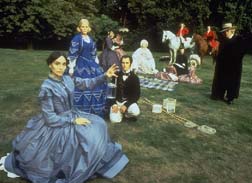
Angels and Insects
directed by Phillip Haas
at various theaters
Victorian England. A gentle and slightly depressed blue-collar naturalist returns from a long research of insects in the Amazons; his ship was wrecked and he lost everything he owned, including the crop of his hard work--a large collection of exotic specimens. He is invited to stay with a pampered, wealthy, and vulgar family in exchange for giving science lessons to their young children. He then gets married to one of their older daughters, not knowing that this will open a can of worms worse than anything he'd ever seen in the jungle.
This film, like Haas's other one (The Music of Chance ) is based on a literary work--Morpho Eugenia, a novella by A.S. Byatt. Like Haas's other film, this one, too, attempts to create drama out of formal estheticism and literalness, while neglecting emotional levels. In this film the scientist represents the world of nature. Through him the camera gapes at an insectarium's luscious mysteries and beauties: colorful butterflies, moths, and ant colonies. The monied family represents the world of civilization and culture, having in hand a different kind of beauty: densely colored clothes, sinfully rich foods, an elaborate mansion filled with servants.
When I read the press release for this film I thought about Mark Dion's work, how it focuses on the old but fascinating conflict of culture vs. nature. I thought that a film, with all it's wide possibilities, would be a great medium for such an exploration. Nature/Culture conflict is indeed the center of Angels and Insects, but unlike Dion's work, Haas's film seems like it is confusingly trapped by that same conflict it tries to explore. Overall, the film acts as an elephant in a china store: it circles a complex, subtle subject with stuffy brutish insensitivity, burdening the viewer with pompous visuals while ultimately staying uninvolved, witlessly missing the point.

The plot, told from the naturalist's point of view, directs us to an unambiguous repulsion from culture, via the creepy behavior and ugly looks of the over-the-top Victorian family. The more the naturalist gets to know the family members, the more he prefers the house's staff's company, eventually becoming desperate to escape back to the jungle and to nature's healthy mysteries. The message here is clear: culture can be very problematic. Contradicting himself, Hass's inflated and stiff estheticizing remains exclusively in the realm of culture's uptight qualities, in a manner not unlike Peter Greenaway's. The result is a cold, empty grandeur that identifies the family's gaudy style with that of the film's own making.
Hass's choice of a vulgar family as a representative for culture is a telling cue to his inability to fully understand and describe his subject matter. It seems that he had never heard about one crucial concept, that of elegance--which is a pivotal quality intrinsic to both nature and culture. He ends up pulling the rug out from under his own feet, creating a contrived film which suffers from the same faults it tries to criticize. The problem, it seems, lies in the inability to recognize that beauty is never exclusively cold and detached; that it always implies an arousal of warmth in the form of longings or love or desire, and that these in turn are not necessarily sick.
-Naomi Ben-Shahar
Email: ThingReviews
To post a response fill out the following form and click the "Submit" button. Or go back...
Scroll down to read messages.
--
Responds:
